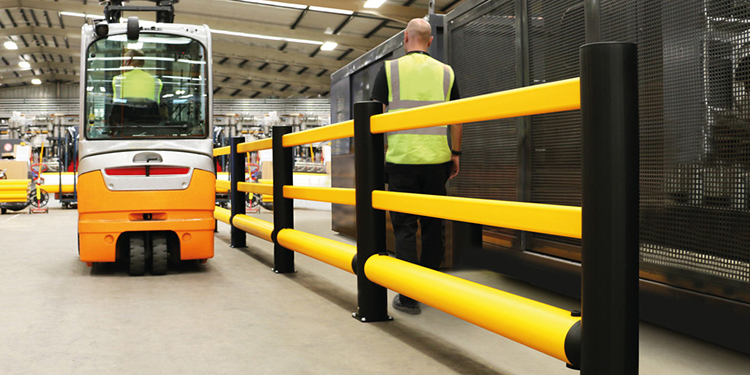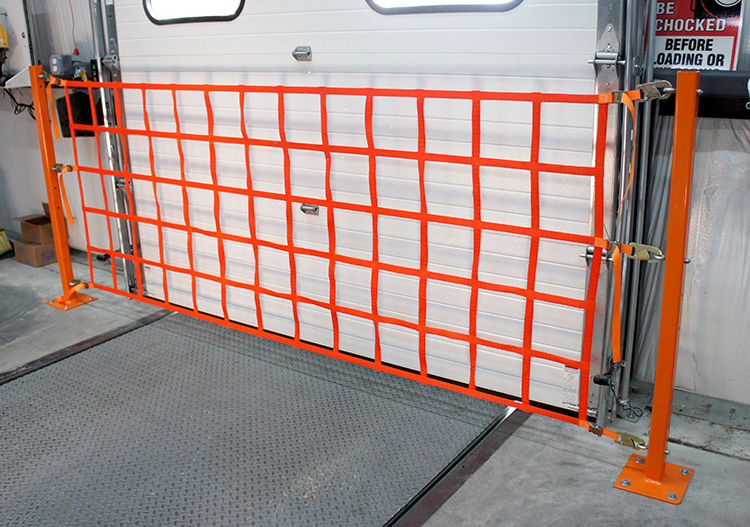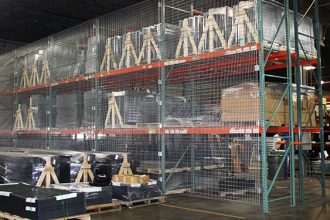Improve Dock Safety With Protective Guarding, Part 1: People

Inbound and outbound loading docks are among the busiest areas within a facility. They’re also among the most dangerous. According to the Bureau of Labor Statistics, between 2015 and 2020, nearly 33,000 employees missed an average of two weeks of work due to injuries that happened in shipping or receiving docks. Worse, 49 workers died from dock-related accidents during the same period. However, it doesn’t have to be this way. It’s possible to improve dock safety with protective guarding solutions that shield people from harm.
“Shipping and receiving docks have a lot going on,” said Aaron Conway, President of Mezzanine Safeti-Gates. The company is a member of the Protective Guarding Manufacturers Association (ProGMA). “It’s the one area of an operation where employees, drivers, products, vehicles, and heavy machinery all intersect. That high level of activity can make it especially dangerous.”
Separate People and Forklifts to Improve Dock Safety
When considering the installation of protective guarding to improve dock safety, Conway advised looking for solutions that reinforce separating personnel from forklifts.
“Specifically, it’s important to minimize the risk of a lift truck striking someone,” he said. “One of the best ways to do this is to create designated areas where people should and should not be.”
 First, examine existing traffic patterns inside the dock doors, Conway said. Then, utilize industrial guardrails to create a physical barrier between pedestrian and forklift traffic zones. These fixed guardrails clearly delineate the two spaces. Notably, however, one type of guardrail will not work for every application.
First, examine existing traffic patterns inside the dock doors, Conway said. Then, utilize industrial guardrails to create a physical barrier between pedestrian and forklift traffic zones. These fixed guardrails clearly delineate the two spaces. Notably, however, one type of guardrail will not work for every application.
“There are many different types of guardrails available to accommodate the many different types of fork trucks that could be in use,” explained Conway. “It’s important to specify the guardrail that will withstand the impact of the type of vehicles in use at the dock.”
To help, ProGMA created the ANSI MH31.2 Test Method for Crash Testing Industrial Guardrail Barriers and Barrier Posts. This standard established a uniform testing methodology to assess the performance of these safety structures. With it, facility owners can more easily compare their options for shielding specific areas such as pedestrian walkways in dock areas.

Additionally, Conway noted, truck drivers visiting the facility are likely to enter the dock area with paperwork. Because they are not employees, they are even less familiar with the traffic flow and are therefore at increased risk of a forklift hitting them. To improve dock safety for these visitors, wire mesh safety cages placed next to the dock doors ensure they cannot enter the dock or facility unaccompanied.
“These driver safety cages also reduce the risk of theft and increase the overall safety and security of the operation,” added Conway.
Improve Dock Safety by Preventing Personnel Falls from Heights

Falls are another potential danger to personnel working at shipping and receiving docks. Elevated to line up with the back of a tractor trailer, dock openings are often several feet higher than the ground outside. A raised dock door increases the risk of a person falling through the opening if a trailer is not present.
“Guarding for dock door ledges needs to be removable when the truck is there, and then replaced when it is not,” Conway said. “A barrier is an ideal solution. They come in a variety of designs to match facility requirements, such as the size of the doorway, the type of material passing through it, and traffic patterns.”
Four primary types of dock door barriers for personnel exist. These include:
- Accordion crossbars that expand as the guarding is pulled across the opening and contract when it is pushed back.
- Hinged barriers that fold up from the middle for storage off to the side of the door opening.
- Netting that stretches across the opening.
- Pivoting guard gates that drops down 90-degrees to obstruct the opening, similar to a railroad crossing guard.

Engineered Barriers Stop Forklifts from Driving Off Open Ledges
To prevent forklifts from driving off dock ledges when the door is open, heavy-duty dock door gates and barriers are available. These engineered solutions account for both the vehicle weight and the potential forces transferred in an impact. Their heavy-duty construction stops the vehicle before it drives over the open ledge — or prevents impact damage to a closed dock door.
Whether installing dock door barriers to prevent personnel or vehicle falls, the optimal solution is the one that employees will actually use, Conway advised.
“Putting a gate or barrier in place is one step. But if its removal or placement is manual, then it’s up to the employees to either remember or to make the effort to use it,” he said. “If it’s heavy or awkward to operate, chances are the barrier will be pushed aside and rarely used. Therefore, it’s important to select a solution that is ergonomic or operates automatically to ensure it’s used.”
To further improve dock safety, manufacturers can add sensors to door barriers and gates. These sensors trigger audible alarms or flashing lights (or both) to alert employees that the protective guarding is open.
Learn More Ways to Improve Dock Safety
The next post will cover protective guarding that improves dock safety for products and facility structures. For more insights into different solutions, download ProGMA’s Protective Guarding Checklist. It lists the most common hazards found in loading docks, as well as potential solutions. Additionally, the members of ProGMA are available to consult onsite and make recommendations, both in dock areas and elsewhere within an operation. Connect with them via mhi.org/progma.



